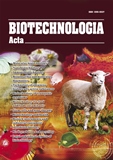ISSN 2410-7751 (Print)
ISSN 2410-776X (Online)

Biotechnologia Acta Т. 16, No. 2 , 2023
P. 24-25, Bibliography 3, англ.
UDC: 577.2
DOI: https://doi.org/10.15407/biotech16.02.024
Повний текст: (PDF, in English)
ACTION OF VENOM OF VIPERA LEBETINA ON BLOOD COAGULATION in vitro
Iskandarov E. 1,2, Dmytruk A.1,3.
1Palladin Institute of biochemistry of the National Academy of Sciences of Ukraine
2Biology And Medicine Institute Science Educational Center оf Taras Shevchenko National University Of Kyiv, Ukraine
3National Technical University of Ukraine “Igor Sikorsky Kyiv Polytechnic Institute”, Ukraine
Aim. In this study we focused on the search of fibrinogen-targeted proteases in the venom of Vipera lebetina.
Methods. Fractionation of the venom was performed using FPLC chromatographic system Acta Prime on Q Sepharose. Analysis of protein mixtures was performed using SDS-PAGE. Аction on blood coagulation system was analyzed using APTT assay [2]. Proteolytic action on fibrinogen and identification of protein components with fibrinolytic activity was performed using electrophoresis of mixture of fibrinogen solution (2 mg/ml) with venom`s fractions. For a comprehensive evaluation of the effect of the obtained fractions on hemostasis, an original approach with modified aggregatometry was used [3]. This approach made it possible to take into account the ability of fractions to activate platelets, initiate blood coagulation, or inhibit platelet aggregation. Hemolytic action of fractions was estimated using fresh human red cells. Amount of released hemoglobin was estimated by spectrophotometry on Optizen POP.
Results. Crude venom of V. lebetina was fractionated using ion-exchange chromatography on Q Sepharose. Elution was performed using a stepwise gradient of NaCl (0.1, 0.2, 0.3, 0.5, and 0.7 M NaCl) in 0.05 M Tris-HCl buffer at pH 8.3. Fractions eluted at 0.1 and 0.2 M of NaCl contained several proteins with different molecular weights ranging from 75 kDa to low molecular weight fractions according to the SDS-PAGE. Proteins that cleave α- and β-chains of fibrinogen were found in fractions 0.1 and 0.2, indicating the presence of an enzyme with fibrinogenolytic activity in the venom of V. lebetina. The fractions 0.3, 0.5, and 0.7 did not show any significant fibrinogenolytic activity. After platelet aggregation study we concluded that fraction 0.1 contained a protein with fibrinogenolytic activity. An increase in platelet aggregation was observed for the fraction 0.2 after the addition of ADP. This may indicate the presence of an active compound that promotes platelet aggregation. Further research is necessary to determine its nature. Fractions 0.3, 0.5, and 0.7 had no effect on platelet aggregation. A decrease in blood plasma clotting time in APTT to 5 s and 7 s, compared to a control value of 70 s, was shown for fractions eluted at NaCl concentrations of 0.1 M and 0.2 M, respectively. The fractions 0.3, 0.5 had only a slight effect on reducing blood plasma clotting. A slightly increased level of hemolysis was shown in the presence of the unbound fraction and the whole venom. It can be suggested that proteins with phospholipase activity are present in the non-binded fraction.
Conclusions. Thus, fibrinogen-specific proteases, hemolytic agents, activators of blood clotting were found in the venom of Vipera lebetina. Most of these compounds must to be purified and can be used for basic biochemical research.
Key words: snake venom, Vipera lebetina, fibrinogenolytic action, protease, APTT, aggregatometry, hemostasis.
© Інститут біохімії ім. О. В. Палладіна НАН України, 2023

